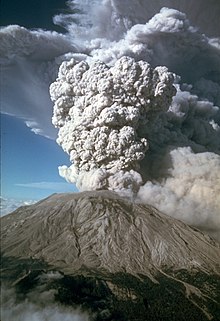
Back انفجار بركاني Arabic Erupció explosiva Catalan Ejektion German Erupción explosiva Spanish Éruption explosive French Letusan eksplosif ID Eruzione esplosiva Italian Ejektioun LB Експлозивен избув Macedonian Explosieve uitbarsting Dutch


In volcanology, an explosive eruption is a volcanic eruption of the most violent type. A notable example is the 1980 eruption of Mount St. Helens. Such eruptions result when sufficient gas has dissolved under pressure within a viscous magma such that expelled lava violently froths into volcanic ash when pressure is suddenly lowered at the vent. Sometimes a lava plug will block the conduit to the summit, and when this occurs, eruptions are more violent. Explosive eruptions can expel as much as 1,000 kg (2,200 lb) per second[1] of rocks, dust, gas and pyroclastic material, averaged over the duration of eruption, that travels at several hundred meters per second as high as 20 km (12 mi) into the atmosphere. This cloud may subsequently collapse, creating a fast-moving pyroclastic flow of hot volcanic matter.
- ^ Mason, Ben G.; Pyle, David M.; Oppenheimer, Clive (2004-12-01). "The size and frequency of the largest explosive eruptions on Earth". Bulletin of Volcanology. 66 (8): 735–748. Bibcode:2004BVol...66..735M. doi:10.1007/s00445-004-0355-9. ISSN 1432-0819. S2CID 129680497.
© MMXXIII Rich X Search. We shall prevail. All rights reserved. Rich X Search